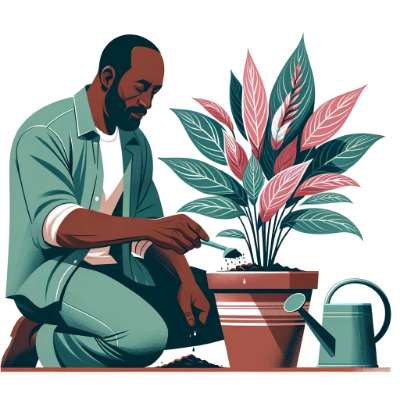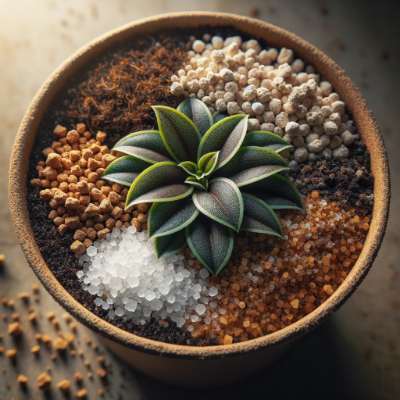Tradescantia Nanouk, additionally referred to as the Wandering Jew, is a famous houseplant recognized for its stunning, variegated foliage. It is a quite smooth-care plant, however it does require nicely-draining soil to thrive. In this newsletter, we will discuss the quality soil mix for Tradescantia Nanouk, in addition to the way to make your very own potting mix at domestic.
Why is well-draining soil important for Tradescantia Nanouk?
Tradescantia Nanouk is susceptible to root rot, that’s a fungal disorder which could kill the plant. Root rot is due to overwatering, which leads to the roots sitting in water for too long. Well-draining soil allows to save you root rot with the aid of allowing extra water to flow out of the pot.
What are the best ingredients for a Tradescantia Nanouk soil mix?
The best soil mix for Tradescantia Nanouk is one that is well-draining, lightweight, and airy. Here are some of the quality components to apply in your potting blend:
- All-purpose potting blend: All-reason potting blend is a good base to your soil mix. However, it’s far crucial to amend it with different elements to enhance drainage and aeration.
- Perlite: Perlite is a light-weight, volcanic rock that helps to improve drainage and aeration.
- Orchid bark: Orchid bark is every other lightweight, nicely-draining material that is perfect for Tradescantia Nanouk. It also helps to preserve the soil acidic, that is the plant’s desired pH stage.
- Coarse sand: Coarse sand also can be used to improve drainage in your potting mix.
According to MyDomaine, a properly-draining houseplant soil mix need to be used for potting Tradescantia Nanouk, and including perlite, orchid bark, or coarse sand can enhance drainage.
House Plant House recommends the use of a houseplant potting mix with orchid bark, perlite, and horticultural grit/sand to preserve your Tradescantia Nanouk glad.
According to Mr.Houseplant, it is vital to apply well-draining soil for Tradescantia Nanouk and amend store-sold potting blend with bark, perlite, pumice, or grit.
Omysa indicates that after potting your Tradescantia Nanouk, you need to use a standard nicely-draining houseplant soil mixed with coarse sand, orchid bark, or other suitable components.
According to Epic Gardening, Tradescantia Nanouk prefers slightly acidic soil with a pH range of 5-6 but also can tolerate impartial soil. Slightly acidic soil can enhance its increase.
Tradescantia Nanouk should be potted in well-draining houseplant soil. This soil holds water and nutrients yet drains and aerates. Perlite, orchid bark, or gritty sand increase drainage. To avoid water damage to domestic surfaces, use a pot or container with a drainage hole and tray. Tradescantia Nanouk will thrive in the correct soil and potting conditions.
Check soil moisture periodically to prevent this. To boost humidity and soil moisture, spray the leaves every few days. When Tradescantia zebrina is pleased, it grows faster and with brighter colors. Keep your plant evenly wet for lush, attractive leaves.

Tradescantia nanouk soil mix recipe

Recipe 1:
Start by mixing equal amounts perlite or coarse sand, peat moss or humus, garden soil, lime, and rich organic compost. This combination will provide your plants the perfect water retention and drainage. Water your soil and examine its drainage after mixing. Lime or peat moss may raise the pH of acidic or alkaline soil. Plants like pH 5–6. Plants thrive with the right soil formula.
Recipe 2:
Tradescantias thrive on light soil. This plant prefers 80% potting soil and 20% perlite. Light soil lets roots breathe and flourish. Heavy potting soil mixtures smother roots and overburden plants. Your Tradescantia will flourish on a light soil mix.
How to make your own Tradescantia Nanouk soil mix

Here is a recipe for a simple, properly-draining soil mix this is best for Tradescantia Nanouk:
- 2 elements all-reason potting mix
- 1 element perlite
- 1 component orchid bark
- Mix all the ingredients collectively in a big bowl or bucket. Be positive to mix them very well so that all of the substances are evenly allotted.
How to pot your Tradescantia Nanouk in your new soil mix

Once you have made your new soil blend, it’s time to pot your Tradescantia Nanouk. Here are a few suggestions:
- Choose a pot that has drainage holes inside the bottom. This will assist to prevent root rot.
- Fill the pot about halfway along with your new soil blend.
- Gently take away your Tradescantia Nanouk from its nursery pot and loosen the roots.
- Place the plant inside the center of the pot and backfill with soil mix, tamping down gently to remove any air wallet.
- Water the plant very well till water flows out of the drainage holes.
Can I use cactus soil for Tradescantia?
Tradescantia may grow in cactus soil, but it must be made for cacti and succulents. Tradescantia needs sunshine, permeable, well-draining soil to grow. To give your Tradescantia the right air, water, and nutrients, buy a cactus soil mix with peat moss, perlite, and sand. To ensure your Tradescantia receives enough nutrients, apply slow-release fertilizer to the soil mix.
What soil for pink Tradescantia?
Tradescantia plants like intense, indirect light from south or east-facing windows. Don’t overwater the plant when the top 2 inches of soil are dry. Soaking the leaves and overwatering the saucer might induce root rot. Feed Tradescantia diluted houseplant fertilizer monthly. To avoid root binding, repot Tradescantia annually.
Can I use succulent soil for Tradescantia nanouk?
Tradescantia nanouk are easy-care plants for beginners. These plants thrive in low to medium light. When the top inch of soil is dry, water them. A soil mix of succulent-specific soil and ordinary potting soil provides excellent drainage and aeration for optimal development. Fertilizing them every two weeks throughout the growth season keeps them healthy and happy. Tradescantia nanouk may beautify any house with proper care.
Should I water my Tradescantia nanouk after repotting?
Repotting Tradescantia nanouk should be done when the leaves start to droop. Give it a vigorous watering until the extra liquid drains from the pot. This will provide optimum root saturation and prevent damage during repotting. Water the nanouk again after repotting. Deep watering is better than shallow watering.
Do Tradescantia need deep pots?
Consider the short root system and top-heaviness of Tradescantia nanouk while choosing a pot. Its broad base and shallow depth make an Azalea Pot ideal for this plant. The broad, shallow base will stabilize the plant and enable the roots to expand. If you have dogs or young children, this will prevent the pot from toppling and hurting someone. You may also put stones or pebbles to the bottom of the pot to anchor it and avoid mishaps.
Tradescantia Nanouk Care

Here are some hints for caring for your Tradescantia Nanouk:
- Place your plant in a brilliant spot with oblique light. Direct sunlight can scorch the leaves.
- Water your plant regularly, however permit the soil to dry out barely between waterings. Be cautious now not to overwater, as this can lead to root rot.
- Fertilize your plant every two weeks at some stage in the developing season (spring and summer season) with a balanced liquid fertilizer.
- Prune your plant often to take away dead or loss of life leaves and stems. This will assist to maintain the plant looking its exceptional.
About Tradescantia Nanouk
Tradescantia Nanouk is simple to grow inside and out. Its long stems with pink, white, purple, and green striped leaves may cascade like ivy. Pink buds and small white and yellow blooms may occur in warmer months. It grows fast and takes minimal maintenance, making it ideal for beginners and experts. Tradescantia Nanouk, patented in the Netherlands, is peculiar to the genera Tradescantia and Zebrina.
Pothos plant Meaning and Symbolism (Feng Shui Benefits)
Conclusion
Tradescantia Nanouk is a lovely and easy-care houseplant this is perfect for beginners. By using a nicely-draining soil mix and following the care guidelines above, you could help your Tradescantia Nanouk thrive for many years to come.
Additional information
Here are a few additional tips for choosing and being concerned for Tradescantia Nanouk soil mix:
- When selecting a business potting blend, look for one this is particularly labeled for African violets or cacti. These mixes are usually well-draining and have a low pH level.
- If you are making your own soil blend, make certain to apply sterilized substances. This will help to save you the spread of pests and diseases.
- When potting your Tradescantia Nanouk, be careful not to overpot. A pot this is too large can lead to root rot.
- Water your Tradescantia Nanouk regularly, but permit the soil to dry out slightly among waterings.
- Fertilize your Tradescantia Nanouk each weeks at some stage in the developing season with a balanced liquid fertilizer.
- Prune your Tradescantia Nanouk frequently to cast off useless or loss of life leaves and stems.
Soil pH for Tradescantia Nanouk
Tradescantia Nanouk prefers a slightly acidic soil pH of five.Five to six.Five. This means that the soil ought to be barely bitter, however no longer too acidic. If the soil pH is just too high, the plant won’t be able to take in the vitamins it desires. If the soil pH is just too low, the plant may be greater prone to pests and illnesses.
You can check the soil pH the use of a pH meter or pH check strips. If the soil pH is not inside the preferred range, you could modify it by way of adding lime or sulfur to the soil.
How to adjust the soil pH for Tradescantia Nanouk
To regulate the soil pH to a barely acidic stage, you could add lime to the soil. Lime is a base, and it’s going to enhance the pH of the soil. To add lime to the soil, blend it in with the soil blend before you pot your plant.
To alter the soil pH to a barely alkaline degree, you could add sulfur to the soil. Sulfur is an acid, and it will lower the pH of the soil. To upload sulfur to the soil, mix it in with the soil blend earlier than you pot your plant.
How to prevent Tradescantia Nanouk from getting root rot
The quality way to prevent Tradescantia Nanouk from getting root rot is to apply a well-draining soil blend and to water the plant frequently, however not too often. You must additionally keep away from overwatering the plant, as this could lead to waterlogged soil and root rot.
If you do note that your Tradescantia Nanouk has root rot, you’ll want to take steps to deal with it at once. The first step is to do away with the plant from the pot and loosen the roots. Then, you may want to cut away any dead or rotting roots. Once you’ve got removed the lifeless roots, you could repot the plant in a brand new pot with sparkling, nicely-draining soil mix.
Troubleshooting Tradescantia Nanouk soil problems
If you are having troubles together with your Tradescantia Nanouk soil, there are some things you could do to troubleshoot the hassle.
- If the leaves of your plant are turning yellow or brown, this can be a signal that the soil is too alkaline. You can strive adjusting the soil pH through including sulfur to the soil.
- If the leaves of your plant are wilting and the soil is wet, this can be a signal that the plant is overwatered. You must lessen the amount of water you are giving the plant and allow the soil to dry out barely between waterings.
- If the leaves of your plant are small and faded, this will be a sign that the plant isn’t getting sufficient nutrients. You should fertilize the plant frequently with a balanced liquid fertilizer.
By following those pointers, you could help to ensure that your Tradescantia Nanouk has the excellent possible soil and is flourishing.
Also Read :
